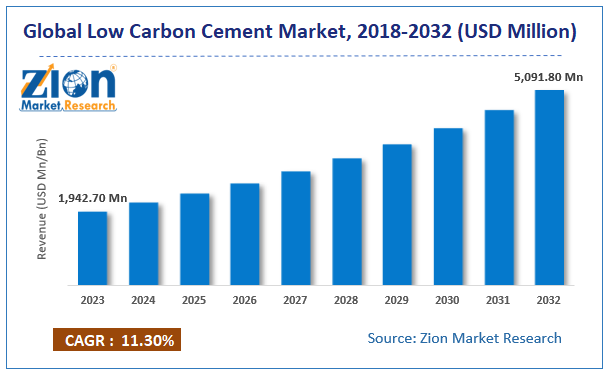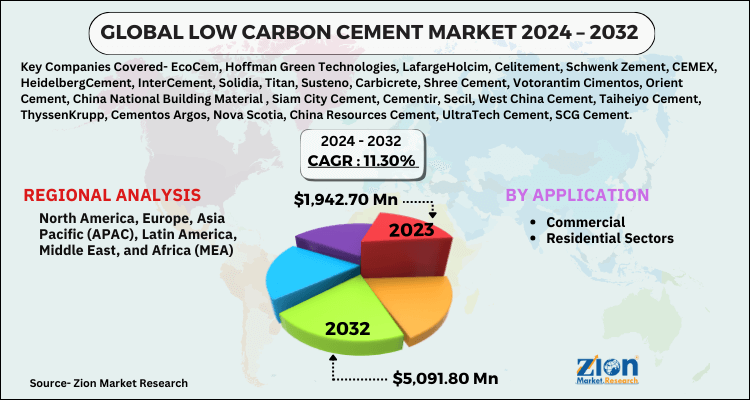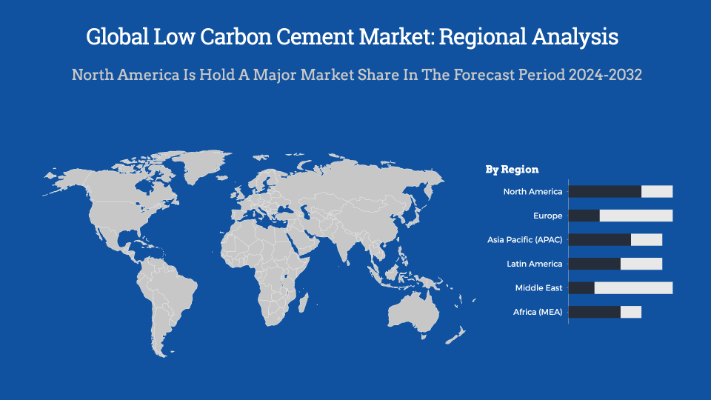Low Carbon Cement Market Growth, Size, Share, Trends, and Forecast 2032

Low Carbon Cement Market By Application (Commercial and Residential Sectors), By Key players (EcoCem, Hoffman Green Technologies, LafargeHolcim, Celitement, Schwenk Zement, CEMEX) And By Region: - Global And Regional Industry Overview, Market Intelligence, Comprehensive Analysis, Historical Data, And Forecasts, 2024-2032
| Market Size in 2023 | Market Forecast in 2032 | Growth Rate (in %) | Base Year |
|---|---|---|---|
| USD 1,942.70 Million | USD 5,091.80 Million | CAGR at 11.30% | 2023 |
Description
Global Low Carbon Cement Market: Insights
According to the report published by Zion Market Research, the global Low Carbon Cement Market size was valued at USD 1,942.70 Million in 2023 and is predicted to reach USD 5,091.80 Million by the end of 2032. The market is expected to grow with a CAGR of 11.30% during the forecast period. The report analyzes the global Low Carbon Cement Market’s growth drivers, restraints, and impact on demand during the forecast period. It will also help navigate and explore the arising opportunities in the Low Carbon Cement Market industry.
 Request Free Sample
Request Free Sample
Low Carbon Cement Market: Overview
Cement is a key contributor to change in the seasonal cycle with the product accounting for nearly about 8% of carbon emissions yearly. Furthermore, chemical as well as heat combustion procedures involved in cement production are the major source of carbon dioxide emissions in atmosphere. Moreover, governments are focusing on reducing carbon emissions from cement and hence are looking for the best & viable as well as affordable alternative in the form of low carbon cement.
Reportedly, few of the stakeholders in the cement industry are expecting firms to offer comprehensive data pertaining to climate risk posed due to the manufacturing of cement & concrete. Governments across the globe are trying to enact & enforce strict emissions laws for cement industry and help the latter comply with the norms of carbon emission set in the Paris Agreement related to climate change. For the record, countries are highlighting on reducing yearly carbon emissions by nearly 16% till 2030 abiding by the environmental protection laws set in Paris accord on climate change. Furthermore, firms are making use of secondary cementitous materials as well as limestone calcimined clay in producing the cement to reduce carbon in their cement products through lowering of the clinker factor in cement. Apart from this, calcium silicate is also utilized in the cement production for reducing the proportion of carbon emissions from the product.
Low Carbon Cement Market: Growth Factors
Growing requirement to effectively combat climatic changes as well as global warming will drive the growth of low carbon cement business over the forecasting years. With growing focus of IEA (International Energy Agency) on promoting energy security, eliminating energy scarcity, and creating environmental awareness, the market for low carbon cement is anticipated to gain traction over the ensuing years. For the record, Cement Sustainability Initiative has been launched by World Business Council for Sustainable Development and is one of the biggest sustainability ventures across the globe undertaken by a single industry like cement. This move is projected to bring an upswing in the expansion of low carbon cement industry in the coming decade.
Moreover, the members of Cement Sustainability Initiative project are focusing on improving their business performance along with strongly committing towards social & environmental responsibility. This, in turn, will proliferate the growth of low carbon cement industry in the ensuing years. With growing trend towards product de-carbonization, a surge in the demand for sustainability credentials for cement & concrete products has been witnessed among the customers in current years. Massive use of secondary cementitous materials by the cement manufacturers for producing low carbon cement will further embellish the market growth trajectory.
Furthermore, researchers are focusing on mixing bacteria with cement concrete formulations and prevent carbon emissions along with improving the properties of cement. Apparently, some of the startup firms in the cement manufacturing business are producing cement-type bricks by using bacteria as well as particles referred as aggregate. For the record, researchers at Colorado Boulder University used cyanobacteria for developing low carbon cement concrete material and produced bricks having property of self-healing the cracks through injecting of sand hydrogen scaffold with bacteria. All these aforementioned aspects will steer the market size over the forecasting years.
Key Insights
- As per the analysis shared by our research analyst, the global Professional Hair Care Products Market is estimated to grow annually at a CAGR of around 11.30% over the forecast period (2024-2032).
- In terms of revenue, the global Professional Hair Care Products Market size was valued at around USD 1,942.70 Million in 2023 and is projected to reach USD 5,091.80 Million by 2032.
- Based on the application, residential construction this sector stands out as the largest consumer of low-carbon cements. The growing demand for sustainable housing solutions has led homeowners and developers to prefer green building materials. Utilizing low-carbon cements in residential projects not only reduces CO₂ emissions but also enhances building durability and energy efficiency.
- Based on the region, the north america this region holds a dominant position in the low-carbon cement market. Governments in North America, particularly in the U.S. and Canada, are enacting stricter laws to reduce carbon emissions, thereby promoting the adoption of sustainable construction materials.
Low Carbon Cement Market: Report Scope
| Report Attributes | Report Details |
|---|---|
| Report Name | Low Carbon Cement Market |
| Market Size in 2023 | USD 1,942.70 Million |
| Market Forecast in 2032 | USD 5,091.80 Million |
| Growth Rate | CAGR of 11.30% |
| Number of Pages | 194 |
| Key Companies Covered | EcoCem, Hoffman Green Technologies, LafargeHolcim, Celitement, Schwenk Zement, CEMEX, HeidelbergCement, InterCement, Solidia, Titan, Susteno, Carbicrete, Shree Cement, Votorantim Cimentos, Orient Cement, China National Building Material , Siam City Cement, Cementir, Secil, West China Cement, Taiheiyo Cement, ThyssenKrupp, Cementos Argos, Nova Scotia, China Resources Cement, UltraTech Cement, SCG Cement, Tianrui Cement, CarbonCure, Dalmia Bharat Cement, CarbiCrete, Norcem, GCC, BioMason. |
| Segments Covered | By Application And By Region |
| Regions Covered | North America, Europe, Asia Pacific (APAC), Latin America, Middle East, and Africa (MEA) |
| Base Year | 2023 |
| Historical Year | 2018 to 2022 |
| Forecast Year | 2024 - 2032 |
| Customization Scope | Avail customized purchase options to meet your exact research needs. Request For Customization |
Low Carbon Cement Market: Segmentation
The study provides a decisive view of the Low Carbon Cement Market by segmenting the market based on by Application and by region. All the segments have been analyzed based on present and future trends and the market is estimated from 2024 to 2032.
By application segment analysis includes commercial and residential Sectors.
The regional segment includes the current and forecast demand for North America, Europe, Asia Pacific, Latin America, and the Middle East and Africa.
Low Carbon Cement Market: Regional Analysis
European low carbon cement market is expected to experience humungous growth over the estimated timespan due to new product launches and adoption of new methods for reducing carbon emissions by firms like LafargeHolcim, EcoCem, HeidelbergCement, and Hoffman Green Technologies based in the region. Citing an instance, in July 2020, LafargeHolcim launched a new low carbon cement product referred as Galaxim Planet cement. Moreover, the product emits nearly twenty-five percent reduced carbon dioxide emission as compared to other conventional cement products. Furthermore, the firm is likely to manufacture nearly 1 lakh tons of low carbon cement products till end of December 2023.
Apart from this, there is a growing trend in the construction sector across Europe for using products having good environmental credentials and this will prop up the regional market expansion within the next few years. For instance, use of low carbon Regen cement alternative by Hanson in London Sewer Venture and utilization of Cemfree cement concrete, a low carbon cement product, by David Ball Group in road project in the UK will further boost the business trends in Europe over the upcoming years. Reportedly, Swiss-government aided LC3 venture has facilitated the use of limestone Calcined clay in the cement. Firms like Hoffman Green Technologies and Cementir in Europe are offering low carbon cement products like H-EVA and FutureCem.
Moreover, a large number of small, local, and giant cement manufacturers in Europe are offering low carbon cement products due to need for strict compliance with EU environmental laws. Additionally, And Norcem – a giant cement manufacturer based in Norway- has planned to transform one of its cement manufacturing unit into world’s first zero carbon emitting cement producing establishment. Reportedly, the unit currently makes use of substitute fuels from wastes and tries to deploy carbon-capturing technologies & storage systems for eliminating carbon emissions completely from its plant by 2030. All these aforementioned aspects will create lucrative growth avenues for the product in the European continent and facilitate huge market penetration in the region over the forecasting timespan.
Global Low Carbon Cement Market: Competitive Players
Key players include:
- EcoCem
- Hoffman Green Technologies
- LafargeHolcim
- Celitement, Schwenk Zement
- CEMEX
- HeidelbergCement
- InterCement
- Solidia
- Titan
- Susteno
- Carbicrete
- Shree Cement
- Votorantim Cimentos
- Orient Cement
- China National Building Material
- Siam City Cement
- Cementir
- Secil
- West China Cement
- Taiheiyo Cement
- ThyssenKrupp
- Cementos Argos
- Nova Scotia
- China Resources Cement
- UltraTech Cement
- SCG Cement
- Tianrui Cement
- CarbonCure
- Dalmia Bharat Cement
- CarbiCrete
- Norcem
- GCC
- BioMason.
The Global Low Carbon Cement Market is segmented as follows:
By Application
- Commercial
- Residential Sectors
Global Low Carbon Cement Market: Regional Segment Analysis
- North America
- The U.S.
- Canada
- Europe
- France
- The UK
- Spain
- Germany
- Italy
- Rest of Europe
- Asia Pacific
- China
- Japan
- India
- South Korea
- Southeast Asia
- Rest of Asia Pacific
- Latin America
- Brazil
- Mexico
- Rest of Latin America
- Middle East & Africa
- GCC
- South Africa
- Rest of Middle East & Africa
What Reports Provides
- Full in-depth analysis of the parent market
- Important changes in market dynamics
- Segmentation details of the market
- Former, on-going, and projected market analysis in terms of volume and value
- Assessment of niche industry developments
- Market share analysis
- Key strategies of major players
- Emerging segments and regional markets
- Testimonials to companies in order to fortify their foothold in the market.
Table Of Content
FrequentlyAsked Questions
Cement is a key contributor to change in the seasonal cycle with the product accounting for nearly about 8% of carbon emissions yearly. Furthermore, chemical as well as heat combustion procedures involved in cement production are the major source of carbon dioxide emissions in atmosphere. Moreover, governments are focusing on reducing carbon emissions from cement and hence are looking for the best & viable as well as affordable alternative in the form of low carbon cement.
The Low Carbon Cement Market was valued at USD 1,942.70 Million in 2023.
The Low Carbon Cement Market is expected to reach USD 5,091.80 Million by 2032, growing at a CAGR of of 11.30% between 2024 to 2032.
Growing requirement to effectively combat climatic changes as well as global warming will drive the growth of low carbon cement business over the forecasting years. With growing focus of IEA (International Energy Agency) on promoting energy security, eliminating energy scarcity, and creating environmental awareness, the market for low carbon cement is anticipated to gain traction over the ensuing years. For the record, Cement Sustainability Initiative has been launched by World Business Council for Sustainable Development and is one of the biggest sustainability ventures across the globe undertaken by a single industry like cement. This move is projected to bring an upswing in the expansion of low carbon cement industry in the coming decade.
Low Carbon Cement Market players such as EcoCem, Hoffman Green Technologies, LafargeHolcim, Celitement, Schwenk Zement, CEMEX, HeidelbergCement, InterCement, Solidia, Titan, Susteno, Carbicrete, Shree Cement, Votorantim Cimentos, Orient Cement, China National Building Material , Siam City Cement, Cementir, Secil, West China Cement, Taiheiyo Cement, ThyssenKrupp, Cementos Argos, Nova Scotia, China Resources Cement, UltraTech Cement, SCG Cement, Tianrui Cement, CarbonCure, Dalmia Bharat Cement, CarbiCrete, Norcem, GCC, BioMason.
HappyClients
Zion Market Research
Tel: +1 (302) 444-0166
USA/Canada Toll Free No.+1 (855) 465-4651
3rd Floor,
Mrunal Paradise, Opp Maharaja Hotel,
Pimple Gurav, Pune 411061,
Maharashtra, India
Phone No +91 7768 006 007, +91 7768 006 008
US OFFICE NO +1 (302) 444-0166
US/CAN TOLL FREE +1 (855) 465-4651
Email: sales@zionmarketresearch.com
We have secured system to process your transaction.
Our support available to help you 24 hours a day, five days a week.
Monday - Friday: 9AM - 6PM
Saturday - Sunday: Closed







